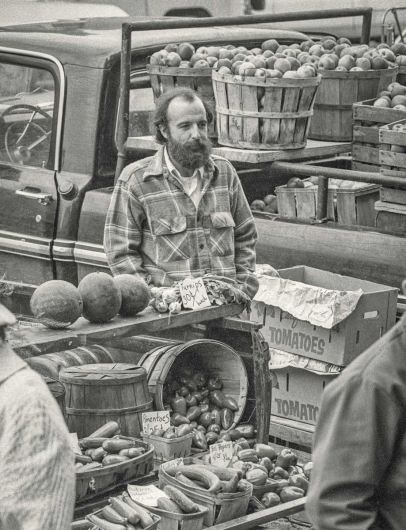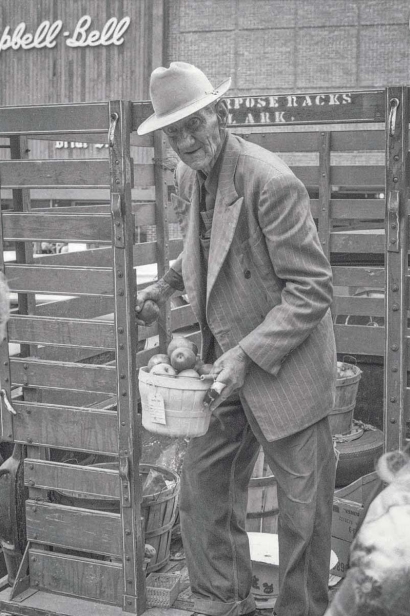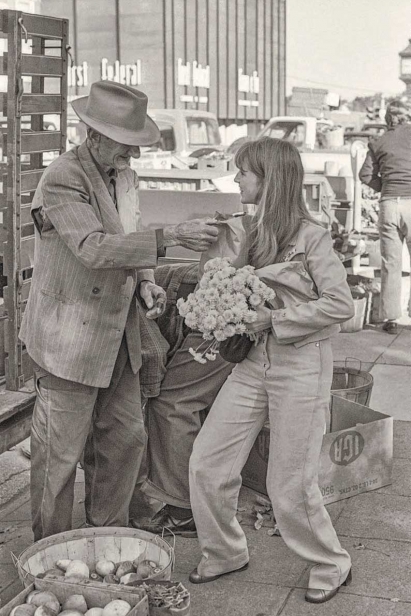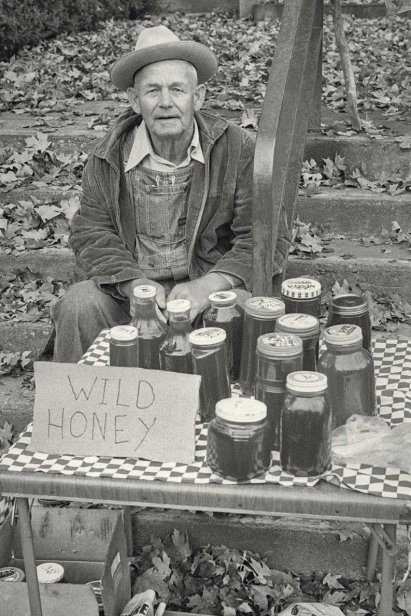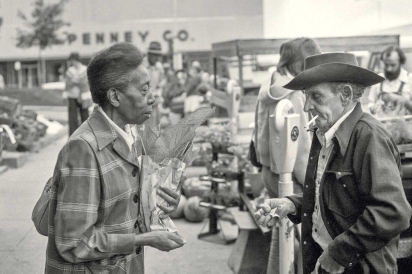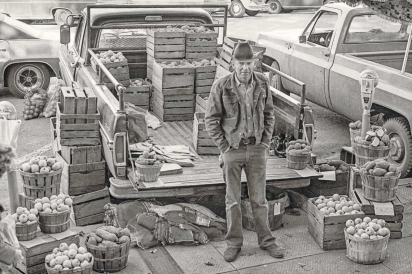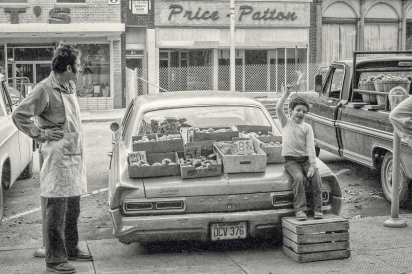A History of Quality: The First Fruits of Farmers Markets in Ozarkansas
Ozarkansas has a deep, rich local food heritage. We may have greater access to fresh food now than ever before because of the prevalence and growth of farmers markets. When we buy our food at the market, we become part of that food story. Not that long ago, however, local foods were difficult to find and that story was much different.
A century past, small farms, orchards, and vineyards covered Ozarkansas, providing fresh, seasonal vegetables and fruits to local groceries and markets. Roadside farm-markets and on-farm markets dotted the countryside. As the American food production system shifted away from small-scale, local production to the current system of larger-scale, centralized industrial farm production centers, and local markets consolidated into national supermarkets and supercenter chains, a part of the local agriculture culture and economy was lost. That was balanced with inexpensive food abundantly available all year long.
As the farming and food retail system changed, and local farmers lost their market, we also lost our connection to the farmers and farms that produced our food. But the Ozarkansas food story does not end there. Now, a resurgent small farm and local food system is blossoming, growing, and flourishing in our region. The "story" about local foods and organic foods is often told about west coast communities like Berkeley, California. However, we have our own story – the Fayetteville Farmers' Market, a 40-year community tradition and the longest continually operating farmers market in Arkansas.
The origin of the Fayetteville Farmers' Market is a combination of history and legend. Although the saga began with the country's shifting food production, other factors were having significant impact. In the 1970s, the country was suffering a significant recession. The rural fruit and vegetable farm economy of the Ozarks was in decline as production in California, Washington, Texas, and Florida was rapidly expanding. Ozarkansas farmers had few markets that would accept their produce, and they were not able to package and ship products that were acceptable to the new supermarkets and ready-to-serve-and-eat needs of the modern consumer.
Locally, the Northwest Arkansas Mall opened in 1972. As the mall attracted additional businesses and customers, the Fayetteville downtown Square lost anchor stores, and shortly thereafter other stores left. The remaining stores and theaters around the Square could not compete with the modern mall and twin cinema. At the same time, new groceries opened in Fayetteville – IGA, two Fairway groceries, and Kroger. Vacant storefronts lined the Square, all ghosts of days gone by.
City civic leaders were concerned about what the deteriorating downtown meant for the hometown. Those leading the discussions included local businessmen John Lewis, local banker and city father, and Morris Collier, pharmacist at Collier's Drug Store and Fountain on Dickson Street. According to legend, Collier said, "We need a farmers market" in downtown Fayetteville.
Others were thinking the same.
The Economic Opportunity Agency (EOA) looked for ways to stimulate the local economy. The rural farm family economy of Washington County was particularly stagnate and struggling. A downtown farmers market would address two problems: the lack of market for farmers and the opportunity to attract consumers back to downtown. A $5,000 EOA grant from the director Charles Johnson was given to Marcella Thompson and Glen Smith, directors of the Community Resource Group, to start a farmers market. The idea and grant began in 1973, establishing the Rural Mountain Producers Exchange (RMPE), and the Fayetteville Farmers' Market was born. The grant initiated the organization and started the market in Fayetteville and other communities in the four-county region. The first market opened during the season of 1974 under the direction of the EOA and managed by Thompson.
In that first year, the market had 10 farmer-vendors and met in a small parking lot one block northwest of the square on Center Street. Legend goes, only about $2,000 to $3,000 of produce was sold that first year from the hoods of cars and the beds of pick-up trucks. When the RMPE advertised for members, the first to sign-up was Wilbur Watson who soon became the first manager of the RMPE and manager of the market for 15 years.
Based on a 19th-century state ordinance stating that cities "must provide a place on the city square for farmers to pull in their wagon" and sell their goods, the RMPE soon entered an agreement with the city of Fayetteville for the annual use of the public areas of the Fayetteville Downtown Square. The market is a strong partnership that benefits everyone – the farmers, the businesses of downtown, the city, and those of us who like the best, fresh, locally grown produce.
From humble beginnings the venture grew quickly. Within 10 years, the market had more than 75 farmer-vendor members, and sales were growing. In the early years, consumers purchased relatively large quantities of produce, pounds and bushels of fruits and vegetables for canning, freezing, juicing, and processing. That trend slowly shifted as consumers bought smaller and smaller quantities, the amount they would use for the week, a few days, or for one meal. Originally, the market only allowed locally grown produce, but they slowly added on-farm homemade handicrafts, and all products had to be sold by the people who produced or made them. Early promotional brochures advertised it as "Hand-picked and Hand-made."
In the first years, the market only occurred on Saturdays for about five months a year. It soon expanded to Tuesday and Thursday mornings over seven months, as well as trying a Thursday evening market and a Sunday market at other locations. In the past few years, the market also has maintained a small winter market. Two new farmers markets have opened in Fayetteville, the Wren Thicket Market and the Green Fork Farmers Market. The Fayetteville Farmers' Market also helped spawn markets in surrounding communities including Springdale and Siloam Springs.
The market has continued to grow and now includes more than 110 farmer-vendors and artisans and a dozen or more food vendors. Musicians, entertainers, artists, and politicians add to the experience. The growth of the Fayetteville Market is an example of the interest in locally grown food nationwide. During the past 20 years, the number of markets in the country has grown more than 450 percent from about 1,700 to more than 8,000 markets. In Arkansas, in the past 15 years, farmers markets have grown from about a dozen to more than 100, including several online markets.
The growth of markets in the United States shows the strong consumer interest in local foods. This fuels the growth of small farms, and now those are one of the most rapidly growing segments of American agriculture. However, local foods only contribute some 2 percent of the national food supply with much room for expansion. This portion of the food system is important not only for producing fresh, nutritious, high-quality foods, but also for the economic impact it makes. Money spent on local foods has an economic impact factor of two to six times as a dollar spent on local food spins and circulates through the local economy, whereas a dollar spent on imported food has only a one to two times the impact factor. Research at the University of Arkansas and other places has shown that farmers markets complement other associated businesses. When consumers come to the market, they also visit and spend money in other stores and restaurants in the proximity. The vision of economic development through the market has proven true. The market, with its economic impact and the sense of community it inspires, contributes to a healthy, sustainable, resilient city.
The perception that local food is too expensive and not accessible for many consumers is not necessarily correct. Farmers markets in Ozarkansas reach many segments of the population and work to reduce food insecurity in the region. Starting a few years ago, the U.S. Department of Agriculture established programs to improve local food availability. As a result of federal grants and with assistance from the U of A, the Fayetteville Farmers' Market and other markets in Northwest Arkansas introduced a program to accept benefits cards and coupons from the federal Supplemental Nutrition Assistance Program and the Senior Voucher coupons program. In the past three years, this part of the Fayetteville Farmers' Market has grown by more than 400 percent. Additional growth in the program has been fueled by a Walmart Foundation grant for the "double your dollar" program, in which those using food assistance cards or coupons could double their purchasing power. Many farmers also contribute unsold produce at the end of the market day to food reclamation efforts, so local food is available to local food pantries and relief kitchens.
The Fayetteville Farmers' Market now has a national reputation and has been featured in several regional and national magazines. It was selected as one of the best shopping destinations by Southern Living magazine and was voted as America's Favorite Farmers Market in a contest sponsored by the American Farmland Trust.
There is a perception that local food is better, and it is. The food at farmers markets is picked ripe, mature, and ready to use. It is not harvested prematurely so as to withstand the rigors of handling, storing, packaging, shipping, and displaying that typical grocery store produce requires. The ripeness and freshness means better flavors, aromas, colors, and crispness. The food will be higher in sugars, acids, and nutrients because they are allowed to fully mature and ripen. Those characteristics will be expressed in recipes and dishes made with local foods.
The Fayetteville Farmers' Market features certified organic, Certified Naturally Grown, and produce grown without or with minimal synthetic pesticides and fertilizers. By their nature, local farmers follow sustainable agriculture farming practices because they want to produce high-quality products as well as maintain and preserve a healthy land upon which they rely for their livelihood.
Many Ozarkansas communities have farmers markets, including Bentonville, Eureka Springs, Fort Smith, Rogers, Siloam Springs, Springdale, and several others. The market managers, with the University of Arkansas Horticulture Department, have created the Northwest Arkansas Farmers Market Alliance to support and promote markets, provide information to farmers and further expand markets in Ozarkansas, providing growing opportunities for farmers and access to high-quality, nutritious, and fresh food for consumers.
For the consumer and lover of food, farmers markets provide a chance to connect to the farmers who work hard to produce food, to the land on which the food is grown, and to the food itself. Markets are also where people meet to share a common experience at a common place. While shopping, people can talk to the farmers and learn about how the produce was grown, and they can learn about the varieties of all the produce on display, each with its own unique history and character.
We then better understand that when we finish preparing that favorite dish and finally put the fork into our mouth, we complete the story of the meal.
But it is more than just a flavor. Eating local food is an experience, a connection, part of a community.
Partaking makes us part of the story.


